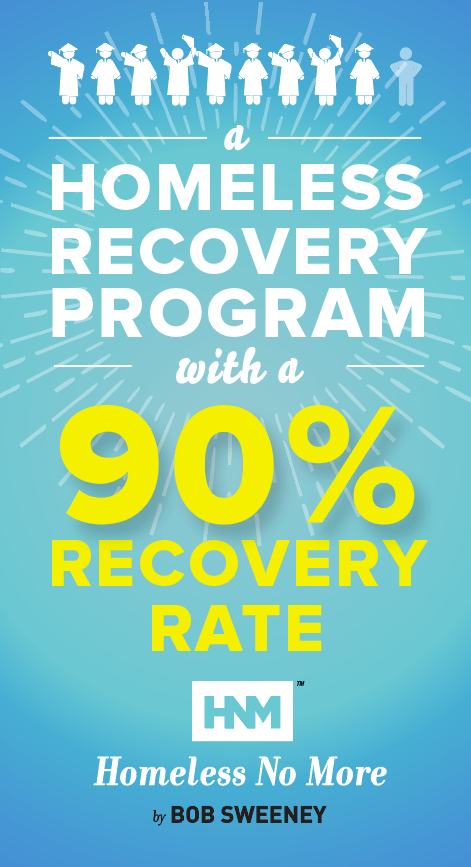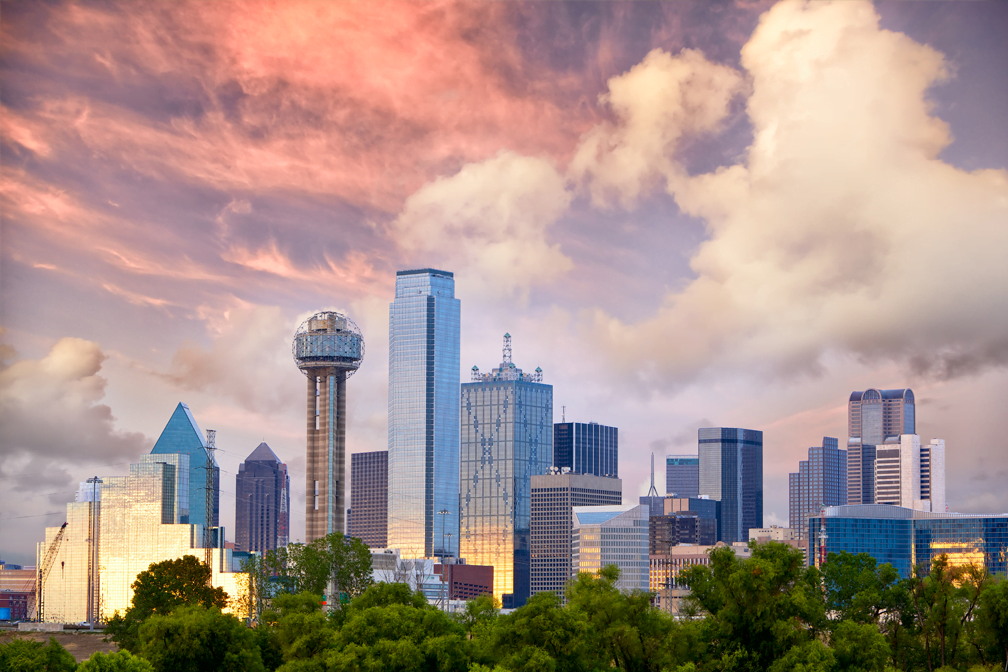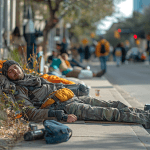As we look at the heart of Dallas today, it’s impossible not to see the stark reality of homelessness stretching across the city. The struggle of those without a home is not just a mere inconvenience; it’s a crisis that demands our attention and action. The streets of Dallas, rich in history and bustling with life, now also narrate a story of those left behind, the ones seeking shelter in the shadows of skyscrapers and under the bridges that connect our city – and even reaching far into the northern bounds of Dallas County.
In recent times, particularly through the lens of 2023, we’ve seen a nuanced picture of homelessness in Dallas. Thanks to concerted efforts and initiatives aimed at addressing this challenge, there’s been a notable shift. A report from Housing Forward highlighted a significant 14% decrease in unsheltered homelessness across Dallas and Collin Counties, marking the lowest count in five years. Moreover, a heartening 32% decline in chronic homelessness indicates that targeted investments and interventions are starting to bear fruit.
Yet, despite these strides towards improvement, challenges persist. Chronic homelessness, although reduced, still saw a dramatic spike previously, underscoring the complexity of the issue. African Americans, representing 59.5% of the homeless population, are disproportionately affected, reflecting deeper systemic inequities that need addressing. 1 The community’s perception of homelessness as a significant issue remains high, with over 75% of downtown residents and more than half of likely Dallas County voters viewing it as a serious problem. 2
But hope is not lost. Initiatives like the Dallas REAL Time Rapid Rehousing have set ambitious goals, aiming to rehouse 6,000 individuals by 2025, potentially transforming countless lives by offering a new beginning. These efforts are supported by the broader community’s dedication to finding solutions and the unyielding spirit of organizations committed to making a difference.
Get Free Our Report: “7 Steps That Get 90% Off The Street”
Where are the most homeless in Dallas today? (2023 Update)
In our bustling city of Dallas, as we navigate through the streets filled with history, culture, and innovation, it’s impossible to overlook the stark contrast presented by the increasing visibility of our homeless neighbors. This situation compels us to confront the realities of homelessness, a pressing issue that’s more than just numbers — it’s about real people facing real challenges every day. As of 2023, we’ve witnessed shifts in the landscape of homelessness in Dallas, marked by both progress and persisting hurdles.
The latest reports, including the 2023 State of Homelessness Address by Housing Forward, reveal a nuanced picture of homelessness in Dallas and Collin Counties. For the first time in five years, the Point-in-Time count — a census of sorts that aims to capture a snapshot of homelessness — recorded 4,244 individuals experiencing homelessness across both counties. This represents the lowest count in half a decade, signaling a 14% decline in unsheltered homelessness and a significant 32% reduction in chronic homelessness. These figures, while heartening, underscore the complexity of homelessness and the varying factors contributing to these trends. 3, 4
Behind these numbers lie concerted efforts to address the issue head-on. Programs like the Dallas R.E.A.L. Time Rapid Rehousing Initiative has been instrumental, with an 18% increase in neighbors moved into housing, thanks to enhanced resources and community collaboration. This initiative, alongside significant investments including $22.8 million in new HUD Unsheltered funds and a $1.25 million contribution from the Bezos Day One Fund, demonstrates a collective commitment to eradicating homelessness. 5, 6, 7
Yet, challenges remain, with over 75% of downtown Dallas residents continuing to perceive homelessness as a significant issue. 8 The demographic analysis sheds light on deeper systemic problems, with African Americans disproportionately affected, representing 59.5% of the homeless population. 9 This data prompts us to look beyond temporary fixes and towards sustainable solutions that address the root causes of homelessness, including systemic inequities and the urgent need for affordable housing.
Get Homeless No More for Your Shelter, Non-Profit or Business.
Dallas Homeless Encampments
In the heart of Dallas, a city known for its vibrant life and dynamic culture, the shadows cast by the struggles of homelessness form a stark contrast. Among the most poignant representations of this issue are the homeless encampments that have become a more visible part of our urban landscape. As of 2023, the city has been grappling with how to address these encampments compassionately and effectively, reflecting a broader conversation on homelessness and housing insecurity.
Overview of Known Encampments
Homeless encampments in Dallas have been a critical concern, with areas beneath highway overpasses, in vacant lots, and secluded city corners becoming makeshift homes for those without shelter. These encampments represent a wide array of individuals and families who, for various reasons, find themselves living on the margins. City efforts to address these encampments have included proposals for significant funding aimed at cleaning, fencing, and, ultimately, decommissioning these sites. 10 In August 2023, the city proposed a $3.6 million budget to raze, clean, and fence homeless encampments as part of a broader initiative to manage the situation more effectively. 11
Challenges Faced by Those Living in Encampments
Life in these encampments is far from easy. Residents face numerous challenges, from the lack of basic necessities such as clean water and sanitation to the constant threat of displacement and violence. Moreover, these encampments are often located in areas that are not safe or conducive to healthy living, exposing residents to hazards and making it difficult for them to find stable footing to improve their circumstances. The city’s approach to decommissioning encampments involves a careful process of engaging with residents, understanding their needs, and facilitating access to housing and services. However, the task is complex, requiring not just resources but also a deep commitment to addressing the underlying causes of homelessness.
Tent City Dallas
In Dallas, “Tent City” emerged as a significant encampment under the I-45 Bridge, serving as a makeshift home for up to 300 individuals. The Metro Dallas Homeless Alliance (MDHA), in collaboration with City of Dallas caseworkers and the Dallas Police Department Crisis Intervention team, embarked on a mission to dismantle “Tent City.” Their efforts focused on ensuring residents were informed about the closure plans and offered services, transitional housing options, and rehabilitation for those battling addiction. As sections of the encampment were cleared, city contractors and Street Services took steps to clean the area and install fencing to secure it, preventing future encampments .
For a deeper look into the efforts made to clear “Tent City” and the assistance provided to its residents, refer to the article: “Metro Dallas Homeless Alliance on track to clear out “Tent City” on Dallas City News. 12
Be a Part of the Change with Homeless No More
The closure of “Tent City” marks a significant step towards addressing homelessness in Dallas, but there is still much to be done. Through donations to Homeless No More, you can help address the urgent needs of those who find themselves without a home. Your support can provide the essential services and housing solutions needed to help our homeless neighbors find stability and dignity. Join us in our mission to make a tangible difference in the lives of those affected by homelessness.
Help Put Someone On The Road To A Better Life
As we navigate the complexities of homelessness in 2023, your support becomes even more critical. Whether through donations, volunteering, or spreading awareness, your contribution can help us extend our reach and impact more lives. Together, we can work towards a future where homelessness is not a defining factor of those who want to recover. See how you can make a difference today.

Dallas Homeless Solution
In Dallas, various initiatives and programs have been developed to combat homelessness, addressing root causes such as drug and alcohol abuse, poverty, broken relationships, mental illness, and acknowledging the housing crisis as a contributing factor. These comprehensive strategies highlight the multifaceted nature of homelessness, focusing on not just providing immediate shelter but also integrating rehabilitation services, mental health support, and efforts to mend broken social ties. Success stories from these programs demonstrate the positive impact of tailored support and housing solutions, offering hope and a blueprint for further improvements. Nonetheless, challenges persist, particularly in scaling these solutions and addressing the broader housing crisis to ensure lasting stability for Dallas’s homeless population.
Dallas has been proactive in addressing homelessness through a variety of initiatives aimed at providing support and housing solutions. One notable program is the Dallas R.E.A.L. Time Rapid Rehousing Initiative, which has been instrumental in helping over 2,700 unhoused people transition to homes by the end of 2023. This initiative is part of a broader effort to increase shelter capacity, provide inclement weather shelters, offer subsidized supportive housing, and invest in facilities combating homelessness. The Office of Homeless Solutions (OHS) in Dallas employs a Four-Track strategy focusing on expanding the capacity of existing providers, managing temporary shelters during severe weather, providing rental and utility assistance, and securing affordable housing units. 13
These efforts are underscored by significant investment from both the municipal budget and federal funds, highlighting the city’s commitment to not only temporary relief but also long-term sustainability in housing. Successes include Dallas LIFE’s Pay to Stay program, which offered thousands of bed nights to those in need, and the landlord subsidized leasing program, assisting dozens of households annually .
Despite these successes, areas needing improvement remain, particularly in increasing the availability of affordable housing and ensuring these initiatives can meet the growing demand. Dallas’s approach reflects a commitment to addressing the complex issues surrounding homelessness with comprehensive solutions and community collaboration. The root causes of homelessness pertaining to individuals include mental health, drug or alcohol dependency, and strained relationships. Not knowing how to navigate financial challenges coupled with economic downturns – poverty in and of itself – is both a personal and societal root which is also linked to affordable housing deficits.
For more detailed information on Dallas’s initiatives to combat homelessness, visit the Office of Homeless Solutions’ website and Housing Forward‘s 2023 State of Homelessness Address for the latest updates and success stories.
Homeless Hotspots Near Me
In Dallas, significant efforts are underway to address the challenges of homelessness, with various hotspots across the city receiving focused attention. Organizations like the City of Dallas’ Office of Homeless Solutions (OHS) and Dallas LIFE Homeless Recovery Center stand at the forefront of these efforts, offering comprehensive services and innovative solutions aimed at reducing homelessness.
Dallas Homeless Solutions Initiatives
The OHS employs a Four-Track Strategy to prevent and reduce homelessness, which includes increasing shelter capacity, providing inclement weather shelters, offering subsidized supportive housing, and investing in facilities combating homelessness. For example, through the Pay to Stay program, OHS has provided thousands of bed nights annually, showcasing the city’s commitment to offering immediate relief to those in need. Additionally, the office works to expand the capacity of existing shelters and has invested significantly in creating low-barrier housing options and enhancing wrap-around services at day centers.
The Role of Dallas LIFE Recovery Center
Dallas LIFE Recovery Center plays a pivotal role in addressing homelessness in Dallas by offering comprehensive recovery programs tailored to help individuals transition from homelessness to self-sufficiency. With a focus on accountability and responsibility, Dallas LIFE provides a structured environment where participants can embark on a path to recovery through a variety of services and programs.
One of the cornerstone programs at Dallas LIFE is the “Homeless No More” Program, which is designed to guide participants towards independent living through structured courses, GED assistance, resume preparation, and job search assistance. This 10-month program boasts a remarkable success rate, with 9 out of 10 residents graduating and becoming Homeless No More. This program is just one example of how Dallas LIFE is dedicated to not just providing immediate shelter but also ensuring a sustainable transition for its residents into a self-sufficient life.
The center also emphasizes the importance of addressing the spiritual and emotional needs of its clients. Executive Director Bob Sweeney highlights the role of spiritual growth and accountability in recovery, stating that the center’s approach is grounded in Christian principles but is open to individuals of all faiths. Clients are not required to convert to Christianity but are encouraged to attend Bible studies and chapel services as part of their recovery process. This unique aspect of Dallas LIFE’s approach aims to provide a holistic recovery, touching on the physical, emotional, mental and spiritual needs of individuals facing homelessness.
Moreover, Dallas LIFE offers an array of services aimed at restoring individuals to wholeness, recognizing that the trauma of homelessness affects every aspect of a person’s life. Services include meals, shelter, clothing, counseling, spiritual care, and access to medical and dental services. The center’s facilities and resources are designed to meet the basic daily needs of its residents while also addressing more profound issues such as addictions, past hurts, and medical attention.
For more information on Dallas LIFE and its programs, you can visit their official website.
How Residents Can Help or Get Help
For those looking to support the fight against homelessness or offer care for those seeking assistance, there are numerous ways to get involved. Donating to or volunteering with organizations like Dallas LIFE can make a significant impact. Residents in need of help can access various services provided by these organizations, from emergency shelter to healthcare and employment assistance.
The comprehensive strategies employed by the City of Dallas and dedicated organizations like Dallas LIFE illustrate a multi-faceted approach to tackling homelessness, emphasizing the need for community involvement and support to achieve lasting solutions.
Where are the Most Homeless People Found in Dallas?
In the diverse landscape of Dallas over the past decade, several large homeless encampments known as “tent cities” have emerged in key locations: beneath the I-45 overpass near downtown, where I-45 intersects with I-30 a mile south of downtown, and on a tract of land close to Malcolm X Blvd. 14
The report from Housing Forward highlighted the closure of 11 permanent encampments, sometimes referred to as “tent cities,” and the permanent housing of 1,871 individuals since October 2021. Despite significant investment, the challenge remains significant, with over 75% of downtown residents perceiving homelessness as a serious issue in Dallas.
Efforts Being Made to Provide Aid and Housing Solutions
Dallas is making strides in addressing homelessness through a variety of initiatives. For example, Housing Forward has set a target to rehouse 6,000 individuals by 2025, aiming to radically reduce the number of homeless individuals in Dallas and Collin Counties. The city has also been purchasing hotels to provide shelter for houseless individuals during the pandemic, though these solutions come with their own set of challenges, such as curfews and visitation limits. 15
Metrocare’s Chief Housing Officer Ikenna Mogbo emphasized the need for zoning law changes to allow for higher densities, which could enable the development of single-room occupancy housing, a solution not utilized in Dallas for decades. This approach aligns with broader calls for more effective and equitable housing policies. 16
_____
How You Can Support the Homeless No More Program
As Dallas continues to navigate the complexities of homelessness, the Homeless No More program stands out as a beacon of hope. By focusing on rehabilitation, education, and direct support, this program has made significant strides in helping individuals transition from homelessness to self-sufficiency – permanently without relapse.
You can support this mission by contributing to the program, volunteering your time, or simply spreading the word about the importance of addressing homelessness with compassion and comprehensive solutions. Every donation helps expand the reach of these programs, ensuring that more individuals and families can access the resources they need to rebuild their lives.
Together, we can make a difference in the lives of our homeless neighbors. Your support can change lives and contribute to the broader mission of reducing homelessness not just in Dallas, but nationwide. Join us in this vital endeavor.
Discover how you can help today and be part of the solution.
By understanding the specific challenges faced in Dallas and supporting targeted efforts like the Homeless No More program, we can collectively work towards a future where everyone has access to stable and dignified living conditions.
Wrapping It All Up
Now, more than ever, your involvement can make a significant difference. Joining Homeless No More in its mission to eradicate homelessness is not just about offering financial support; it’s about becoming part of a community dedicated to fostering hope, dignity, and independence among those who need it most. Whether through volunteering, advocacy, or donations, every effort counts towards building a stronger, more supportive Dallas for everyone.
The road ahead may be long, but it’s paved with the successes of those who’ve found stability and safety through these programs. Their stories remind us of the transformative power of compassion, and the impact we can make when we come together for the greater good.
To become part of this crucial mission, consider how you can contribute to the cause. Explore Homeless No More to see how your support can directly benefit individuals (including veterans, seniors, single parents and the disabled) and families striving to overcome homelessness. Together, we can provide the resources, care, and opportunities necessary for everyone in our city to thrive.
In conclusion, the homelessness crisis in Dallas is a reflection of broader systemic issues that require a unified response. By supporting Homeless No More and similar initiatives, we contribute to a future where homelessness is not a defining feature of our city’s landscape, but rather a challenge that is met with unwavering solidarity and compassion.
References
- https://unitedwaydallas.org/updates/the-state-of-homelessness-in-2022/
- Ibid.
- https://housingforwardntx.org/blog/state-of-homelessness-address-2023/#:~:text=During%20the%20State%20of%20Homelessness,lowest%20count%20in%20five%20years.
- https://www.hudexchange.info/programs/hdx/pit-hic/#2024-pit-count-and-hic-guidance-and-training
- https://dallashomelesssolutions.com/our-initiatives/dallas-r-e-a-l-time-rapid-rehousing/
- https://www.hud.gov/
- https://www.bezosdayonefund.org/
- Collin Pruett, https://dallasexpress.com/city/dallas-214-spike-in-chronic-homelessness/
- Ibid.
- Soli Rice. https://texasscorecard.com/metroplex/city-of-dallas-proposes-spending-4-1-million-to-remove-homeless-encampments/#:~:text=The%20budget%20proposal%2C%20brought%20by,to%20%E2%80%9Cclean%E2%80%9D%20up%20encampments.
- Jason Beeferman, https://www.dallasnews.com/news/2023/08/08/city-proposes-41-million-to-raze-clean-and-fence-homeless-encampments/#:~:text=The%20city%20plans%20to%20spend,the%20%E2%80%9Ccleaning%E2%80%9D%20of%20encampments.
- https://www.dallascitynews.net/video-metro-dallas-homeless-alliance-on-track-to-clear-out-tent-city#:~:text=The%20Metro%20Dallas%20Homeless%20Alliance,the%20I%2D45%20Bridge%20home.
- https://dallashomelesssolutions.com/our-initiatives/
- https://humanrightsdallasmaps.com/items/show/28#:~:text=Among%20the%20largest%20homeless%20encampments,land%20near%20Malcolm%20X%20Blvd.
- https://dallasexpress.com/city/dallas-214-spike-in-chronic-homelessness/
- https://dallasexpress.com/city/dallas-214-spike-in-chronic-homelessness/
0019





